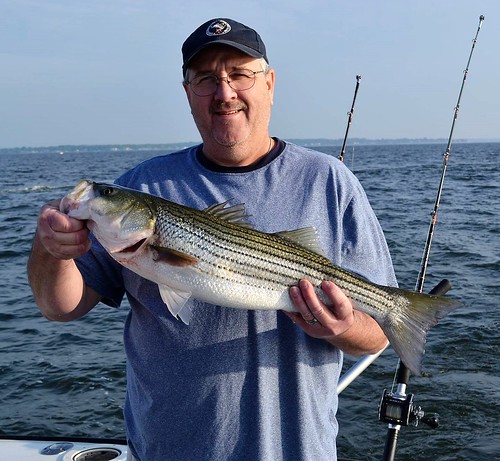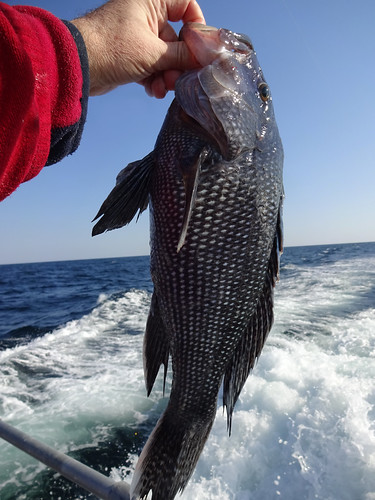By: Keith Lockwood
The recent cold front that clobbered us with stiff winds, cold temperatures and gale warnings on the bay seem to have set the stage for what is to come in regards to cold weather. It was very unfortunate indeed that lives were lost on the lower Potomac over the weekend due to rough conditions brought on by stiff winds. Hopefully the winds will subside soon and many will be able to get out on the water for a traditional Thanksgiving morning of fishing before the big turkey event. Be careful out there, water temperatures are cold, everyone is wearing a lot of clothing and please wear a life jacket or vest when fishing on open waters, especially on windy or choppy days. Make sure you have enough PFDs for all on board, and check the safety equipment on your vessel before leaving the ramp or dock.
The water temperatures at the top of the bay continue to drop in the Susquehanna/Elk River area. There have been some early afternoon water releases at the Conowingo Dam but not on a regular schedule. There has been a good topwater bite in the Susquehanna and lower Elk Rivers in the evenings with a fair number of legal-sized fish. Some are having good luck trolling deep with crankbaits and swim shads in the lower part of the rivers and along the channel edges farther south.
The striped bass fishing action is expected to regain momentum once small craft warnings are lowered on the upper Chesapeake. It was pretty stiff out there into yesterday but some did find haven in the leeward shores of the western side of the bay in the tidal rivers. The Patapsco, Gunpowder and Magothy Rivers have been offering some topwater action in the mornings and evenings in about 10' of water.
Others have had luck jigging in the channels for a mix of striped bass and white perch or slow trolling deep with heavy inline weights and bucktails. There are a high percentage of sub-legal striped bass but definitely worth the time to put a couple of legal fish in the boat. Mike Kvech holds up a nice striped bass he caught near Hart/Miller Island.

Photo courtesy of Montana Grant
Once the winds lay down, fishing should resume out in the main stem of the upper bay with most of the focus along deep channel edges for the larger fish. Water temperatures are taking a nose dive with the colder weather and stand at about 52 degrees today. The fishing action is expected to diminish with these colder water temperatures as bait heads down the bay and fish start to hunker down in the deepest areas and begin to become less active.
The Bay Bridge will continue to hold a mix of striped bass and white perch near the deeper parts of the rock piles and piers. Vertical jigging will be the main way to target these fish and it will take some weight to get to them when the current is running strong. Below the bridge there are white perch and striped bass holding along some of the deeper edges of the main shipping channel and to a lesser extent the channels at the mouths of the major tidal rivers. As has been the case this fall, there are a lot of small fish spread throughout the region and it can be tough at times to find a nice grade of fish. Jigging deep will continue to be a light tackle fun way to fish but trolling can also be very effective. It takes a lot of lead to get tandem rigged bucktails down to where the fish are holding.
Water temperatures will most likely begin to dip below the 50 degree mark by next week and striped bass will show decreased activity and will be holding deep. The salinity in the middle bay region is about 18 p.p.t. which is considerably high for this time of the year. We are going on our fourth month with hardly any rain and without freshwater pouring in from the tidal rivers higher salt content water is pushing up the bay with each tide. This is okay for fish but you may find white perch and channel catfish in places you normally don't see them this time of the year. These high salinities are not good for oysters since the diseases that hamper their survival are more prevalent in higher salinity waters.
Once the winds lay down, some places to check will include the shipping channel edges off Kent Island and near Thomas Point, the False Channel at the mouth of the Choptank, off the Little Choptank and the mouth of the West River have been good places to check. Most fish encountered close to the surface will be smaller fish; the larger ones will most often be deep. Ted Kolobow caught this nice striper north of Bloody Point while jigging deep just before the weekend winds hit.

Photo courtesy of Ted Kolobow
In the lower bay region there has been good fishing for striped bass in the lower Patuxent and Potomac Rivers along the main channel edges. Jigging and trolling have been equally good ways to hook into some fish. Smaller fish as usual have been very common but there are some larger fish to be found deep. There has also been good action at the mouth of the Nanticoke River, off Hooper's Island and along the western side of the shipping channel. It may take some time to find the fish size you're looking for but this is typical for this time of the year. Colder water temperatures are slowing fish down and once water temperatures drop into the 40's action will be even slower.
White perch are holding in deep water at the mouth of the Patuxent and Nanticoke Rivers and can be found over hard oyster bottom. A bottom rig baited with pieces of bloodworms or a jig with a dropper fly are good choices to target them. There are also a few sea trout around.
There is good fishing for blue catfish in the tidal Potomac and the catfish are generally holding in 25' of water or more. There are plenty of medium sized ones to catch and they certainly make a good addition to any freezer. The grass beds farther up the river are breaking up due to shorter daylight hours and cold water conditions so fouled lines will be something to contend with.
Still no rain! That is what western Maryland and most of Maryland has been dealing with for the last several months. Water levels in the western Maryland rivers, streams and reservoirs are very low. The state boat ramp at Deep Creek Lake and others on the upper Potomac are unusable or barely so. At Deep Creek Lake water temperatures are beginning to dip below the 50 degree mark. Fishing for smallmouth bass has been good and jigs and crankbaits that resemble crawfish have been the best lures to use. The bass are feeding heavily on crawfish that are moving towards deeper water and cover to sit out the winter months. Walleye fishing is picking up and yellow perch fishing has been good. Live minnows either drifted free or under a slip bobber is a good way to fish for them. Chain pickerel and northern pike are much more active now with colder water temperatures. Look for them along deep grass and at the mouths of many of the shallower coves.
Trout fishing remains a fun option but it will take some stealth as they may be concentrated in the deeper pools due to low and clear water conditions. As the stocked trout from October become more accustomed to not being fed at the hatchery they will be looking for aquatic insects and smaller fish, so flies, spinners and even ultra-light sized jerkbaits are good choices to fish with very light line. The upper Potomac has the same water level conditions this week so tubes and crankbaits cast with light line would be a good choice when targeting smallmouth bass.
Largemouth bass are doing the same strategy as smallmouth bass but typically in lakes, ponds and tidal rivers throughout Maryland. Shorter daylight hours and colder temperatures are causing grass beds to die back for the winter and small baitfish and particularly crawfish have lost their cover so they're headed for deep structure for the winter months. To reach these deeper areas where they might find places to hide, they have to cross barren bottom and that is where largemouth bass are waiting for them. Hair jigs, tubes, soft plastic craws on a jig head, small crankbaits, basically anything that looks like a crawfish is a good bet when worked close to the bottom. Sean Allen was fishing the Gunpowder recently and got into some wonderful largemouth bass action such as this beauty.

Photo courtesy of Sean Allen Sr.
Ocean water temperatures continue to drop and they are very close to passing the 50 degree mark. In the surf fishermen are patiently waiting for the main body of migrating striped bass to arrive from New England waters. New Jersey anglers have been getting in their licks this past week but reports have most of the southbound fish far offshore and in the protected area in the Federal Exclusive Economic Zone or "EEZ" (fishing for striped bass is illegal in the Federal EEZ in the ocean, which starts 3 miles offshore and extends out to 200 miles off the coast). A few large striped bass are being caught this week in Ocean City and Assateague surf, perhaps this week things will really hit high gear.
Large bluefish are also part of the fall migration and these are the biggest and baddest of their species, with many weighing 12 lbs. or better. They will soon start showing up at the sea bass fishing sites and should be found on the inshore shoal areas and surf zones soon.
At the inlet and Route 50 Bridge area, tautog and striped bass have been the big focus. Many of the tog are undersized but if one sticks with it you can catch your limit of legal fish. There are also plenty of striped bass in the area and again a high percentage are short of the required 28" but they're close. Casting bucktails, swim shads, drifting cut menhaden baits or live eels have been the choicest ways to fish for them.
Outside the inlet at the offshore wreck and reef sites boats have been putting their anglers on some excellent sea bass and tautog fishing. Limit catches of sea bass and tautog are not uncommon. There is also a mix of flounder, medium sized bluefish and a few triggerfish coming over the rails. Richard Gunion holds up a nice sea bass for us on the way back to port.

Photo courtesy of Richard Gunion
Boom...Morgan
No comments:
Post a Comment